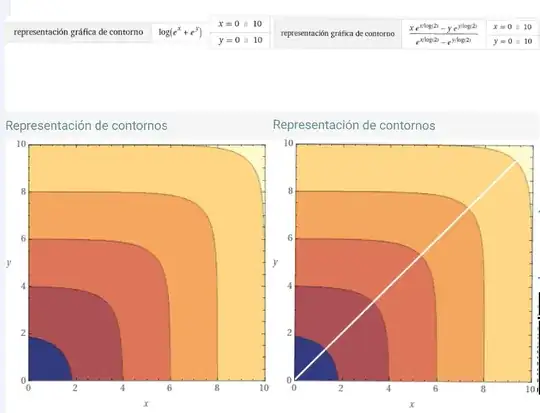We will break this into 3 parts.
Part $1$ provides derivation of an series expansion for $\log(1+e^x+e^y)$ in terms of powers of $e^{-\left(x-y\right)}$, where it is assumed that $e^x>1+e^y$. This is equivalent to assuming that $x-y>\log\left(1+e^{-y}\right)$
In Part $2$, we develop a series converges rapidly when $x-y$ is adequately small. This development is motivated since the series in Part 1 converges slowly when $x-y$ is small.
Part $3$ provides upper and lower bounds that are global (i.e., We impose no conditions on $x$ or $y$.).
PART $1$:
Without loss of generality, assume $x>y$. Let $M=e^x$ and $m=e^y$ and further assume that $m+1<M$ to write
$$\begin{align}
1+e^x+e^y&=1+m+M\\\\
&=M\left(1+\frac{m+1}{M}\right)
\end{align}$$
Then$$\log(1+e^x+e^y)=\log(M)+\log\left(1+\frac{m+1}{M}\right)$$
Using the Taylor series for $\log(1+x)$ yields
$$\log(1+e^x+e^y)=\log(M)+\sum_{n=1}^{\infty} (-1)^{n+1}\frac{1}{n}\left(\frac{m+1}{M}\right)^n$$
Next, using the binomial theorem to expand $\left(\frac{m+1}{M}\right)^n$ yields
$$\begin{align}
\log(1+e^x+e^y)&=\log(M)+\sum_{n=1}^{\infty} \sum_{p=0}^{n}(-1)^{n+1}{n \choose p}
\frac{1}{n}\left(\frac{1}{M}\right)^nm^{p}\\\\
&=x+\sum_{n=1}^{\infty} \sum_{p=0}^{n}(-1)^{n+1}{n \choose p}
\frac{1}{n}e^{-\left(nx-py\right)}
\end{align}$$
Examining the first few terms reveals
$$\begin{align}
\log(1+e^x+e^y)&=x+e^{-(x-y)}-\frac12e^{-2(x-y)}+\frac13e^{-3(x-y)}+e^{-x}\left(1-e^{-(x-y)}+e^{-2(x-y)}\right)\\\\
&+O\left(e^{-2x}\right)
\end{align}$$
This provides a good series expansion in powers of $e^{-(x-y)}$ when $e^{-(x-y)}<1-\frac{1}{1+e^y}<1$. However, the speed of series convergence decreases with decreasing $x-y>0$.
Part $2$ considers the case in which $x-y$ is "small."
PART $2$:
To address the case for which $0<x-y<1$, let's reexamine the term $\log\left(1+\frac{m+1}{M}\right)$. Set $s=-(x-y)$, and $w=M^{-1}$, and consider the function
$$f(s)=\log\left(1+w+e^s\right)$$
We proceed to expand $f$ in a Taylor series. Evaluating the derivatives up to third order at $s=0$ yields
$$\begin{align}
f^{\left(0\right)}(s)&=\log(2+w)\\\\
f^{\left(1\right)}(s)&=\frac{1}{2+w}\\\\
f^{\left(2\right)}(s)&=\frac{1}{2+w}-\frac{1}{\left(2+w\right)^2}\\\\
f^{\left(3\right)}(s)&=\frac{1}{2+w}-\frac{3}{\left(2+w\right)^2}+\frac{2}{\left(2+w\right)^3}
\end{align}$$
Next, note that the terms $(2+w)^{-k}=\frac{1}{2^k}\left(1+\frac{w}{2}\right)^k$ can be expanded as
$$(2+w)^{-k}=\frac{1}{2^k}\left(1+O\left(w\right)\right)$$
where only the leading term was retained under the tacit assumption that $x>>1$ so that $w=e^{-x}<<1$. This permits simplifying the derivatives of $f$ as
$$\begin{align}
f^{\left(0\right)}(0)&=\log(2)\\\\
f^{\left(1\right)}(0)&=\frac12\\\\
f^{\left(2\right)}(0)&=\frac14\\\\
f^{\left(3\right)}(0)&=0
\end{align}$$
Finally, we can express $\log(1+e^x+e^y)$ as
$$\begin{align}
\log(1+e^x+e^y)&=x + f(0) + f^{(1)}(0) \left(-(x-y)\right) + \frac12 f^{(2)}(0) \left(-(x-y)\right) + O\left(\left(x-y\right)^4\right) + O\left(e^{-x}\right)\\\\
&=\log(2)+\frac12(x-y)+\frac18(x-y)^2+O\left(\left(x-y\right)^4\right)+O\left(e^{-x}\right)
\end{align}$$
since $f^{\left(3\right)}(0)=0$. This validates the answer posted by @Travis for small $x-y$ and adds the last term to provide a strict equality.
PART $3$:
We may also obtain crude bounds as follows. For the upper bound we have
$$\begin{align}
1+e^x+e^y&=(e^x+e^y)\left(1+\frac{1}{e^x+e^y}\right)\\\\
&<2\max(e^x,e^y)\left(1+\frac{1}{2\min(e^x,e^y)}\right)\\\\
\end{align}$$
Now use (i) the series for $\log(1+x)$ and (ii) the fact that the $\log$ is a monotonically increasing function, which implies $\log\left(\max(a,b)\right)=\max\left(\log(a),\log(b)\right)$ to reveal
$$\log\left(1+e^x+e^y\right)<\log(2)+\max(x,y)+\frac12\max\left(e^{-x},e^{-y}\right)$$
Under the assumption that $x>y$, this upper bound becomes
$$\log\left(1+e^x+e^y\right)\le\log(2)+x+\frac12e^{-y}$$
For the lower bound, we have
$$\begin{align}
1+e^x+e^y&=(e^x+e^y)\left(1+\frac{1}{e^x+e^y}\right)\\\\
&\ge2\sqrt(e^xe^y)\left(1+\frac{1}{e^x+e^y}\right)
\end{align}$$
Now use (i) the series for $\log(1+x)$ and (ii) the inequality for the geometric and arithmetic means to reveal
$$\begin{align}
\log(1+e^x+e^y)&\ge \log(2)+\frac12\left(x+y\right)+\frac{1}{e^x+e^y}-\frac12\left(\frac{1}{e^x+e^y}\right)^2\\\\
&\ge\log\left(2\right)+\frac12\left(x+y\right)+\frac12\min\left(e^{-x},e^{-y}\right)-\frac18\ \max\left(e^{-2x},e^{-2y}\right)
\end{align}$$
Under the assumption that $x>y$, this lower bound becomes
$$\log(1+e^x+e^y)\ge\log\left(2\right)+\frac12\left(x+y\right)+\frac12e^{-x}-\frac18\ e^{-2y}$$

